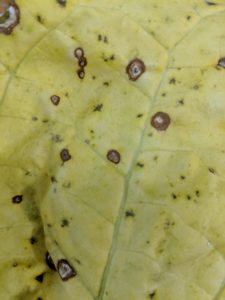Fungicide Resistance Found in Frogeye Leaf Spot of Flue-Cured Tobacco
go.ncsu.edu/readext?546903
en Español / em Português
El inglés es el idioma de control de esta página. En la medida en que haya algún conflicto entre la traducción al inglés y la traducción, el inglés prevalece.
Al hacer clic en el enlace de traducción se activa un servicio de traducción gratuito para convertir la página al español. Al igual que con cualquier traducción por Internet, la conversión no es sensible al contexto y puede que no traduzca el texto en su significado original. NC State Extension no garantiza la exactitud del texto traducido. Por favor, tenga en cuenta que algunas aplicaciones y/o servicios pueden no funcionar como se espera cuando se traducen.
Português
Inglês é o idioma de controle desta página. Na medida que haja algum conflito entre o texto original em Inglês e a tradução, o Inglês prevalece.
Ao clicar no link de tradução, um serviço gratuito de tradução será ativado para converter a página para o Português. Como em qualquer tradução pela internet, a conversão não é sensivel ao contexto e pode não ocorrer a tradução para o significado orginal. O serviço de Extensão da Carolina do Norte (NC State Extension) não garante a exatidão do texto traduzido. Por favor, observe que algumas funções ou serviços podem não funcionar como esperado após a tradução.
English
English is the controlling language of this page. To the extent there is any conflict between the English text and the translation, English controls.
Clicking on the translation link activates a free translation service to convert the page to Spanish. As with any Internet translation, the conversion is not context-sensitive and may not translate the text to its original meaning. NC State Extension does not guarantee the accuracy of the translated text. Please note that some applications and/or services may not function as expected when translated.
Collapse ▲Environmental conditions this growing season have been conducive for several pathogens in flue-cured tobacco. Frogeye leaf spot (Cercospora nicotianae) has been particularly severe this growing season, affecting ripe and green leaves on all portions of plants. These leaf spots are characterized by a darkened margin with a white middle. Sometimes these lesions will have black specks in the center, which are spores that continue the disease cycle. Normally, this disease is of minimal consequence to North Carolina tobacco, but it has caused significant damage to unripened tobacco leaves.
After reports of frogeye leaf spot control failures in flue-cured tobacco fields, samples of leaf spot lesions were tested for strobilurin fungicide resistance. These lesions tested positive for strobilurin resistance in the lab. Conditions for this disease may continue to be favorable, and conventional fungicides labeled for flue-cured tobacco (azoxystrobin) will not be effective for managing frogeye leaf spot. Several biological pesticides are labeled for managing leaf spots in tobacco, but information for their efficacy on frogeye leaf spot in flue-cured tobacco is limited or not available. Destroying crop debris quickly at the end of the growing season will help to reduce this disease for future crops.
Update to Anonymous Response:
We are currently assessing other chemistries, especially biological, to assess their utility for Frogeye Leaf Spot, Target Spot, and Brown Spot control in tobacco. PRC and Organic tobacco have been produced for a number of years, and these chemistries are new to the market. As soon as data from North Carolina is completed, an update will be made available. Expect more details on the portal and at winter production meetings. If you’d like to discuss options for PRC and Organic tobacco foliar disease management, please contact your local extension agent or the tobacco pathologist.



